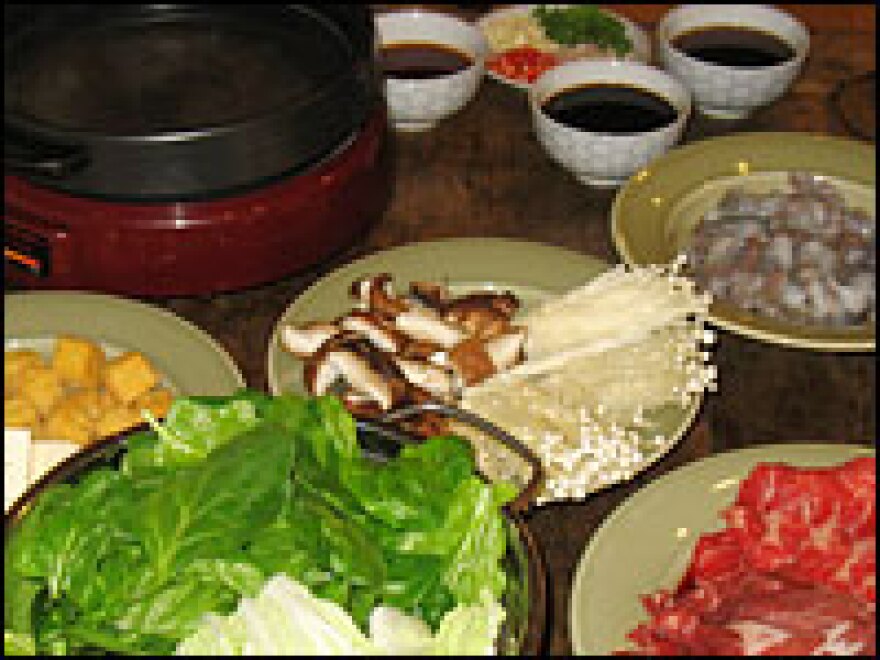
The first group of ingredients is a rundown of the basics of a Pao family hot pot meal (a * denotes items that you may only find at an Asian supermarket or specialty store). My parents don't like lamb, so we never had it at home, but it is another traditional hot pot meat. Clams and other shellfish are also an option, although not with my parents. Chicken is used, but must be cooked thoroughly and care must be taken not to get raw chicken on eating utensils. It's too much of a headache, so my folks don't use it either.
Keep in mind, too, that if you leave some of the ingredients off, you may want to add more of the things you keep. These amounts should be used as guidelines; depending on how hearty your appetite, you may have leftovers.
Serves 4-6 healthy eaters
1 to 2 pounds beef eye round, sliced paper thin across the grain (brisket and flank steaks are other popular cuts; depending on how thin the meat is, you may want to stick it back in the freezer to make it easier to separate slices)
1 to 1 1/2 pounds large shrimp, shelled, deveined and slit on one side
2 pounds spinach, washed and roughly chopped or ripped
1 medium to large Napa cabbage, washed and roughly chopped
2 boxes firm tofu, cut into 1-inch cubes
1 pint carton of button mushrooms, cleaned and cut in half
2 to 3 ounces cellophane noodles (also known as glass noodles, bean thread noodles, mung bean noodles; buying them in small packages makes for easier separating), soaked in warm water and drained*
Water (cooking liquid)
For a More Elaborate Meal, Add Any of the Following Items:
Clams (cleaned)
Scallops
Fish, shrimp or cuttlefish balls (defrosted, if frozen)*
Imitation crab sticks (defrosted, if frozen)
Lamb (also sliced paper thin, across the grain)
Chicken (cut into 1/2-inch or so slices)
Leafy greens (baby bok choy, Chinese broccoli or pea shoots, roughly chopped or ripped)*
Mung bean sprouts (rinsed)*
Shiitake, enokitake or other mushrooms (cleaned, large caps should be cut in half)*
Different varieties of tofu (two favorites are "oily tofu" and "tofu skin," defrosted, if frozen, cut if needed into bite-size pieces)*
Different varieties of frozen small dumplings (partially defrosted)*
Chicken, beef, vegetable broth or specialty hot pot broths (available in packets)*
Suggested Ingredients for Dipping Sauce:
Soy sauce
Sesame oil
Sesame paste
White or rice vinegar
Shacha sauce (the Bull Head brand is widely considered the tastiest)*
Minced garlic, shallots or chili peppers
Chopped coriander
Setting the Table:
A round table works best. Place the hot pot in the center of the table; fill it with whatever cooking liquid you're using (don't forget there will be lots of food floating around, so don't overfill).
Depending on how many people are eating, you may want to prepare multiple plates of each ingredient so it's easier for people to reach. Those go on the table, too, family-style, as do all the various condiments for making a dipping sauce. You can plop the bottles down on the table, or present the liquids in cruets or bowls.
Each diner should have a bowl (for dipping sauce and food from the hot pot), a pair of chopsticks (or a fork) and a spoon. A communal ladle (or two) is nice to have around.
We don't eat steamed rice with our hot pot meals, but you can certainly offer that, if you like.
Preparing Dipping Sauce:
Some good combinations for dipping sauces include soy sauce, sesame oil and shacha sauce; soy sauce, sesame oil, sesame paste and coriander; soy sauce, rice vinegar, garlic and chilis. There is no right or wrong. One tip: Go easy on any one ingredient (especially the liquid ones — try starting out with just a couple of teaspoons) until you've had a chance to taste the mixture.
Cooking:
When you're just about ready to sit down, turn on the hot pot and bring liquid to a boil; then lower heat and keep the liquid at a gentle simmer. You may need to adjust the temperature during your meal or replenish the cooking liquid.
It's best to put any items that need longer cooking (semi-frozen dumplings, for example) in early to ensure thorough cooking. Also, it's nice to put any bean-curd products in early, as they absorb a lot of flavor during the cooking process.
Use common sense while cooking; if your shrimp is still translucent, it's not done. Generally, nothing (except the frozen dumplings) requires more than a few minutes of cooking. (The dumplings — which will float to the top when they're done — take 5-10 minutes, depending on size).
In our family, the cellophane noodles go in last. The liquid — ordinary water in our family's case — becomes a tasty, fragrant and very healthy soup. We also refill the pot one last time with liquid and dump in all the leftover food, for soup and noodles the next day.
Copyright 2023 NPR. To see more, visit https://www.npr.org. 9(MDM3NjYwMjA5MDE1MjA1MzQ1NDk1N2ZmZQ004))

